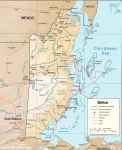
 |
I left Livingston before dawn, with the goal of reaching New Haven Bight in Belize before dark. Livingston can be a difficult place to sail out of in the morning, as there is often not much wind and the tide is coming in. This morning was no exception. Malakii and I flapped around for quite a while. It took forever to reach the Livingston Sea Buoy, just outside of the bar across the mouth of the Rio Dulce. By noon I was still piddling around over by Cabo Tres Puntas.
Because I wanted to make New Haven by evening, I finally gave up and decided to run the engine a little. When the wind died completely, I would wait ten minutes or so, then fire up the engine. I did this on three or four occasions, motoring until a breeze appeared. However, about the fourth time I started it, it began making a horrendous racket and I discovered the key between the prop shaft flange and the prop shaft was out, and the bolts which were supposed to hold it in place weren't doing any good.
Just before I made this discovery, the wind had come up. I was not sailing along nicely, and because of the time, needed every mile I could make, so I didn't want to slow down. Unfortunately, the pressure of the water against the prop was causing the prop shaft to spin, and since the shaft was disconnected from the transmission, putting the engine in gear did nothing to stop it. Under some conditions, on other boats, this situation would have resulted in the prop shaft sliding out the bottom of the boat to be lost forever, and leaving a one inch hole in the bottom where water could come gushing in. Fortunately, Malakii's prop shaft zinc to prevent galvanic corrosion is bolted onto the prop shaft between the hull and the prop shaft strut, so when the shaft slips outward the zinc prevents the shaft from leaving the boat entirely. In addition, the prop is a three blade fixed prop, so one of the blades would come up against the rudder if the zinc wasn't there. That could possible make steering difficult, but because the zinc was in place I didn't have to convern myself with that.
I didn't want the shaft free-wheeling, as it would eat up the zinc and wear on the strut. Furthermore, I wanted the shaft connected, so I could use the engine if I needed it for some reason. It is amazing how, given an engine, you want it to work, even if you don't need it. If I didn't have it, it wouldn't bother me, but since I had it, I wanted it to work. I spent about fifteen minutes dinking around trying to inch the prop shaft back up towards the interior of the boat, so I could reinstall the flange with the key in place. I could stop the shaft rotation with a pipe wrench, and then by rotating the wrench back and forth I could move the shaft forward a bit. But my forward boat speed, which I was reluctant to sacrifice, put so much pressure on the prop that I couldn't get it inside enough to reinstall the flange properly. I finally backed off enough to look at my predicament objectively, realizing I didn't need the damn engine for anything, and said to heck with it. I tightened down the pipe wrench so the shaft wouldn't turn, and wouldn't want to exit the boat, closed the cockpit locker lid, and got back to the more enjoyable business of sailing.
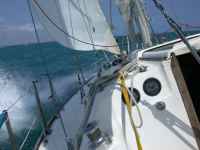 |
| On the way from Livingston to Placencia |
The usual afternoon breeze was piping up pretty good, so I reefed down the mainsail for most of the trip from Tres Puntas on. The wind was right on our nose, a condition which seems to occur more often than statistics would justify. I made it in by 1745, with about a half hour of light left. I was glad it is an easy entrance and good holding and I was familiar with it.
The next morning I reattached the prop shaft, an easy job now that there wasn't any pressure against the propeller. In the process I noticed the autopilot was going bonkers, and was worried it had died on me. I subsequently discovered it had just gone on walk about, a common response for autopilots when one places big steel dive tanks directly in front of their internal compasses. Doh...
I was working my way north to meet Lynde in about a week, and hoping to hook up with some friends and neighbors from Ovando who were vacationing north of Placencia on the way. I planned to check into Belize at Big Creek, just south of Placencia. The weather was unstable, but the sailing was good. I spent much of my time with two reefs in the main, and decided I really need a third set of reef points in the main for when things get serious. I also discovered that when we take a lot of water over the windward rail it drains into the cockpit instead of overboard -- right on top of the autopilot. Not a good situation...
We passed a turtle out in the middle of nowhere, swimming along as turtles do. It was a medium-sized one, two feet of so.
My new GPS antenna, the Garmin one, has a slot on the bottom part of the mount, which leaves an open hole to the pole it is mounted on. When the wind is whistling pretty good it sounds like far away oriental flutes. I like it.
The port of Big Creek is located up a dredged creek channel. The port has a shoreline dock for small freighters which come in to load concentrated sugar cane molasses for export. The entrance channel is dredged and buoyed for several miles, as it runs through shallow flats with patches of coral here and there. Then it takes an abrupt turn and heads into the mangroves in a channel about 120 feet wide, with a sharp turn at the end. There is a wide spot where the dock is located, just enough for a tug to spin the ships around before towing them out.
I sailed into the buoyed channel, and began tacking up the channel. As I approached the point where it entered the mangroves, I decided I'd better turn on the engine, as the wind was on my nose, I'd never been in there, and I didn't know what to expect. Fear and uncertainty make cowards of us all...
However, when I went to start the engine I discovered the gearshift and throttle were stuck. It is a stupid all in one combination mechanical non-marvel, and I was now paying the price of someone in Malakii's past not paying attention to the KISS concept -- "Keep It Simple, Stupid." I either had to turn around and go up to Placencia to find a place to anchor and fix the gearshift, or sail up the narrow channel.
Throughout my adventures with Malakii, I've tried to keep in mind that people have sailed without engines for centuries, and that Malakii is a boat that sails well. She may not be the most modern, and her gear may be a bit worn and abused and not very pretty, but she is a stout vessel and she does her job remarkably well. What problems we have should generally be laid at my feet, not hers. So we headed into the channel, with a brief thought about how often ships actually use this piddly little channel.
We made it up to the wide spot opposite the dock, where a ship was tied up and being loaded. Nervous about how long she would stay there, and not knowing how long it would take to check in, and wanting to fix the gearshift / throttle, we eased over to where the creek entered the makeshift bay. There were three buoys marking the more or less end of the dredged area, with just enough room beyond to turn around and anchor without running aground.
I launched the dinghy, installed the outboard, putted across to the other side, and wandered up the dirt bank and over to the port captain's office, where I checked in. Then I headed for the immigration office, three miles away. It was beastly hot, but I managed to hitch a ride both up and back.
On my way up to Immigration, before getting a ride, I had passed a small building with a sign saying something about the Belizian or Central American banana growers' association. The Belizians won't let you bring anything in, claiming it's to prevent disease from neighborning countries from contaminating their crops. Since I didn't have much fresh produce and I was starving, on my way back to the boat I walked in their and said to the nice woman at the desk, "Since this is the home of the banana growers' association, you wouldn't happen to have any spare bananas for sale, would you?" I didn't expect her to have any; after all, it was a business office, not a plantation building. But you never know... She just happened to have a box of bananas, probably ones that were too ripe to ship, and she handed me a small bunch. I thanked her for her generousity, then headed over to my last stop, the agricultural inspector.
Government bureaucracies seem to be the same everywhere. Some are more efficient than others, but none are particularly efficient, and all seem to be filled with absurd rules which do little to actually accomplish whatever their officially stated purpose happens to be. This one was no exception. I was asked about any produce on board, and informed the lady that I had five oranges, a watermelon, and three carrots. She informed me that I was not allowed to bring oranges or watermelon into the country, and she would have to confiscate them. I was starved, and fresh O.J. and watermelon sounded awfully good, and I hate wasting good food. So I asked if I could eat them right now, and she said yes. I figured she'll trust me to return to the boat and eat them, but I should have known better. After filling out her papers, she says she'll have to come out and inspect the boat, so I lead her through the weeds and down to the dink, and we putt over to Malakii. She manages to board with some help, and I show her below. Once there, she does a look inside a few cupboards and under one settee while I cut and squeeze orange juice, saving the peels and seeds for her in a bag. Then I cut the melon, offer her a piece, and dig into the rest. I give her the best piece, a slice from the center. She seems a bit surprised that I really am going to eat the watermelon. I devour one end, then go to work on the other; I am hot and dry, and it is a real treat. After eating an end section, I drain the juice into my mug, straining out the seeds as I drink it. Juice dribbles into my beard and down my chin.
I ask the Ag lady what part the bugs travel in; she says the rind, the seeds. I ask her if there's anything you can bring into Belize, she says no fruits or veggies, even ones not grown here. For those you need a permit, like apples. If I had apples from Canada she would confiscate them because I have no permit. When they were worried about mad cow disease they were confiscating yogurt.
By the time I'm done, she has nibbled a few bites. I add the rind from the ends and the seeds to the sack of orange peels; she fidgets, anxious to be going. We double bag the sack of garbage, and I run the dink back to shore and drop her off. When I return, I finish off her portion, spitting the seeds over the side. If they really cared about the spread of some disease, she wouldn't leave her piece of melon on the boat. It's laughable. There's no way to stop bugs from working their way north from Guatemala; it's a hospital environment the whole way, full of local fruit stands and farms and villages. What they are really trying to do is protect their own small agricultural base. I have no problem with that, but let's call it what it is. You can buy Guatemalan produce in Belize seven days a week.
I spent the evening enjoying the quiet solitude and taking the gearshift apart, filing down some worn spots, greasing it, and generally trying to persuade it to not stick again.
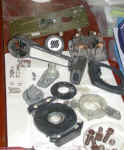 |
| Gearshift/Throttle in Pieces |
The next morning I got to see how tight the maneuvering room really is, as the resident tug turned the freighter around and towed it out. The wind was blowing straight down on me from the freighter as they turned her lose from the dock and threw a line to the tug from the stern. They missed, and I watched with some nervousness as her stern started swinging my way. The second toss was good, and after making fast, the tug yanked the stern around, cast off the line, scooted to the bow of the freighter, secured another line, and began towing her out the channel.
In the photos below, the small buoy between Malakii and the stern of the ship is about a hundred feet away from us.
 |
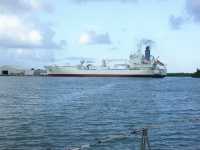 |
 |
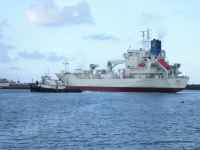 |
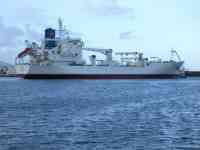 |
| First you get a line | Then you yank the stern | Pulling as hard as you can | All the way around | Then run to the bow and head out |
I wondered how many ships go in and out of Big Creek, and decided not many. I was trying to decide whether or not to attempt to sail back out, but the wind was extremely light and I thought I should test out the repaired gearshift. So I started the engine and headed out... and met the tug towing another ship in. We passed easily, but I was glad I wasn't under sail.
I motored the two miles up to Placencia, where I stopped for supplies, ice, and to fill my dive tanks. I checked email, hoping to hear from my friends Kathy and Travis who were supposed to be north of Placencia for a week of vacation. I sent them a note saying I'd look for them that evening, but we didn't connect.
Sailors are famous for reading prodigously, but I haven't quite got it figured out yet. Maybe it's because I'm not making any long passages. Maybe it's because their boats are in better shape than Malakii, and they don't have as much work to do. Maybe they lie around one place longer than I do and just hang out and read. Maybe they have all new lines and someone else did the rigging so there's no splicing to do. Maybe all their drawer pulls and hatch cover handles and latches are stainless and don't break and work perfectly even in rough seas. I dunno. The good ship Malakii has lots to occupy my time, so I have to fit the reading in here and there.
I had a few days before Lynde arrived in Belize City, so I ghosted over to Scipio Cay on almost empty winds, then took a bath and snorkeled around the cay. Didn't see any big stuff, probably because there's a fisherman's camp on the cay and they have harvested everything in sight. But it was fun to snorkel in clear water for a change, and the coral on the windward side was healthy.
The replacement depth sounder, a 2" humminbird, works ok, but it's a pain in the eyeballs to use. It is very difficult to read in sunlight, as the LCD display "oils out." At least that's what I call it. The background area looks faintly rainbow smeared, as if a drop or two of oil was got behind the face and spread around by capillary action. In addition, the decimal is very tiny, so 10.1 and 101 look the same from a distance of more than a few feet. You would think you'd know which one it had to be, but when coming up on a reef from deep water it's not always so clearcut. So it's fine as a backup, but I wouldn't recommend it as a primary.
The wind picked up after I ate lunch, and I zipped on north the five miles or so to False Cay, where I anchored. I had about an hour before sunset, and Travis and Kathy were supposed to be staying at Ocean's Edge Guest Cottages; According to the owners, False Cay was "right in front of them." I hopped in the dink and headed to the mainland, stopped at the first place I saw, and asked directions. Fortunately, the woman I met knew where they were -- "clear to the north, past the last dock." I worked my way north, inquiring a few more times, but nobody else seemed to know. It was getting pretty rough and I was about to turn back when I saw them, so I zoomed up and beached the dink. A woman and her son who were renting a neighboring cabin told me Travis and Kathy had just left to go to town, probably for dinner. She also told me they were planning on going snorkeling so I left them a note on their porch and headed back to the boat.
I finished carving a wooden handle for the companionway hatch cover; we'll see how well it lasts. It's not particularly pretty, but it is functional.
 |
| New Companionway Hatch Handle |
The next morning I had a slow sail North inside False Cay. I watched two small boats head up in the direction of Travis' and Kathy's, expecting them to leave shortly thereafter. I was hoping to be in the vicinity, hoping they would swing by for a chat on their way to wherever they were going to snorkel. But the boats didn't re-emerge, and I was going nowhere fast, as the morning breeze slowly died. But I was slowly working my way out of the bight and leaving Kathy and Travis' cottage in the distance. I was poking my nose back into whatever book I was reading when up zipped a boat and I was hailed with a big yell. Yippie! They had gotten my message the night before, but their guide had been late due to motor problems. They had decided he wasn't coming and had unpacked, so getting ready had to leave had taken a bit longer. We had a quick chat and then they were off, and I inched my way north.
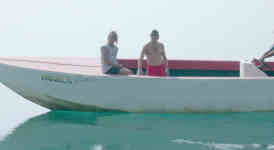 |
| Travis and Kathy |
The wind picked up, and I decided I could reach Belize City in a long day from Tobacco Range, so I anchored there for the night. It was incredibly peaceful, with a wonderful moonrise. I spent the next day taking it easy and sightseeing.
I started the morning out with my first attempt at baking on the stove, in the pressure cooker with the weight gizmo off. You put the goods to be baked in a pan inside the pressure cooker, suspended above the bottom by whatever means you can conjure up; the pressure cooker acts like an oven. For this experiment, I made cinnamon rolls. They came out great, and I was ecstatic!
I also discovered that those hermetically sealed packages of instant oatmeal, which I have kept for over ten years at home without trouble, don't last in the tropics. They aren't moisture proof, so they mold. Good thing I have plenty of more appetizing things to eat.
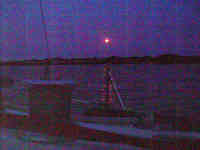 |
| Tobacco Range Moonrise |
I took the dink over to Man-O-War Cay, named after the large colony of Frigate (Man-O-War) Birds that nest there. There are also a lot of boobies. The frigate birds puff up their red throat bags so they look like balloons, which turn to turkey wattles when they deflate.
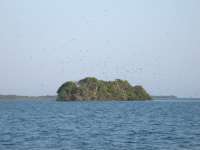 |
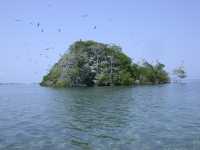 |
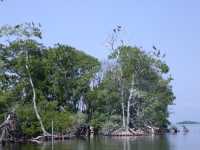 |
| Man-O-War Cay | ||
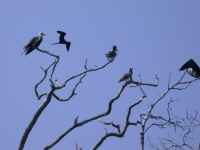 |
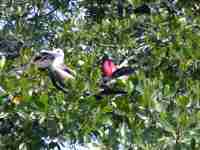 |
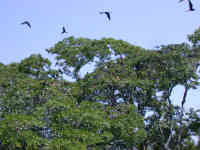 |
| Frigate Birds | ||
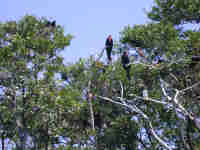 |
 |
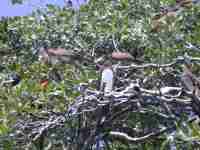 |
| Frigate Birds and Boobies | Boobies | |
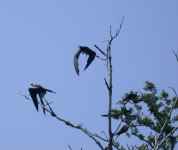 |
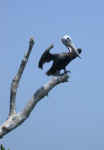 |
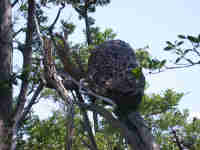 |
| Dead bird | Pelican | Termite Mound |
On my way back from Man-O-War Cay, I trolled a little and caught a small barracuda which promptly cut my 20# test line with its sharp teeth. The water wasn't very clear, and visibility was only about ten feet. As I was rowing up the narrow channel between two cays where I was anchored, I noticed a big, odd white blob on the bottom. When stopped for a closer look, it seemed to move. It turned out to be a manatee! I grabbed my camera and snapped some pictures. It never surfaced more than to stick it's nose up for a lungfull of air, so I didn't get much for photos.
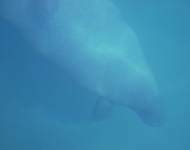 |
 |
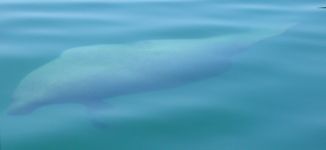 |
| Manatee |
The next day I headed out early for the long run to Cucumber Beach Marina south of Belize City. I was running wing and wing and suddenly realized it was good spinnaker weather, so I popped it up and had a fun ride. Another sailboat was heading the same direction, so we were in an unofficial race. They beat me by a hundred yards or so to the buoy at the marina. I was disappointed... until I learned they had their engine going.
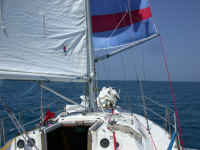 |
| Heading to Pick up Lynde |
I spent the next day running errands and buying supplies. Lynde arrived, tired, so we spent the night in the marina and headed out early the next morning, back south to Tobacco Range. We romped in a building wind all the way down, so by the time we got there it was blowing pretty good. I was going to motor in, but the gearshift stuck so we tacked up to the tiny anchorage, a narrow slot between two cays, and dropped the hook. Two other boats were there, one of them being Kristiana, with our friends Doug and Rayene from Montana. We had a great visit and spent a few days snorkling and resting up, cooking freshly speared fish for dinner.
Then we sailed out the cut south of Southwater Cay and over to Glover's Reef, one of Belize's three offshore atolls. We had a great sail over, a bit of an exciting time negotiating the cut at the south end, as we were too far west; then wove our way north inside the reef and up to Long Cay. The wind was right on our nose and we had to look pretty sharp to dodge everything on our way up to Long Cay. We had briefly visited there last year, but this time we stayed longer and did some snorkeling and diving.
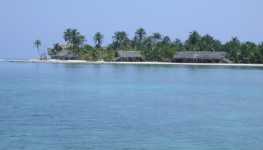 |
| Long Cay, Glovers Reef |
On one of our dives we saw a huge Goliath Grouper, otherwise known as a Jewfish. It was about six feet long, and I'm sure my head would fit in its mouth.
We had fish for dinner on numerous occasions, and were slowly learning the art of spearfishing.
We wanted to head up to Lighthouse Reef for some more snorkeling, but there was a front forecast to come through. As I wasn't familiar with Lighthouse I was reluctant to stay there in bad weather. So we rounded the tip of Glovers and headed over to Turneffe, where we did some snorkeling and general lazing about. Unfortunately the picture below isn't too good, but if you look at the larger version you can see the light turquoise water of the shallow water inside the reef, and the obvious breaking waves where the reef breaks the surface. We're sailing in about 50 feet of water with spur and groove coral on the bottom. The coral bottom drops off sharply, from being at the surface a hundred or so yards to our left where the lighthouse is, to being over 600 feet deep a hundred or so yards to our right. There's no land in sight, although on a good day from higher up you could make out one of the cays to the south. It's no wonder Belize's offshore atolls are littered with shipwrecks.
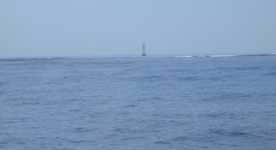 |
| Lighthouse, N end of Glovers Reef |
Then we headed back inside the barrier reef. While anchored off the reef one day to snorkel, we watched one of the gargantuan cruise ships go in the main channel by English Cay. The ship dwarfed everything, an alien monster in a small world. Cruise ships are the scourge of island ecosystems. They usually dump tourists ashore for a day only, so local hotels and guest houses get little benefit. The ships sail prompty in early evening, so restaurants get little benefit as well. Passengers scurry about in a frantic attempt to "see Belize" in one day, and end up seeing very little, and a distorted view at that. Operations catering to the cruise ship tourists dump boatloads of them at the same site, overwhelming it and reducing it to a disneyland toy. Cruise ship ground tackle is huge. When they anchor, they destroy large areas of coral reef when their humongous chain drags across the bottom. In the right-hand photo below, the light house on English Cay is 62 feet tall. That's about six stories, yet it's dwarfed by the cruise ship.
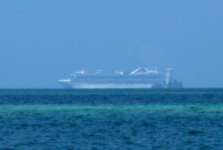 |
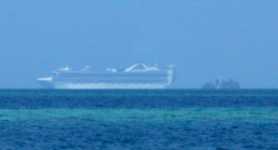 |
| Cruise Ship passing English Cay | Cruise Ship passing English Cay |
We spent an afternoon snorkling north of Rendzevous Cay, and got some fish for another great dinner. Then we headed back to Belize City, where I dropped off Lynde, resupplied, and headed out again.
 |
| Rendezvous Cay |
I left Cucumber Beach Marina at 0900, flying wing and wing. After a while I raised the spinnaker. I left the main up, but the wind eased and the main ended up blanketing the spinnaker, and it wrapped around the forestay.
Up high.
Way up high.
I spent a long time staring up.
I spent a little time tugging gently on various lines.
I spent a little more time easing the spinnaker halyard.
Eventually I accepted it was wrapped really well.
I took a long look at English Cay, where I was headed, and decided it was still a good ways off. Then I got out the mast mate, my long webbing ladder, and hoisted it up on a spare halyard. I made sure that "Auto", my trusty first mate, was steering properly. I thanked the sea gods that the wind hadn't piped up yet. Then I climbed up to where the wrap was, about half way between the spreaders and the masthead. I made sure my safety harness was clipped in well and my second safety line was attached to another halyard, they leaned way out towards the forestay. I could barely touch the spinnaker, but I got enough of it between two fingers to undo the first wrap. I don't remember how many wraps in all there were, but eventually I got them undone. I scooted down as fast as I could, doused the spinnaker, reorganized, and thought a bit.
I decided flying a spinnaker was kind of like riding a horse. If you get bucked off, you need to get right back on before you get too scared to try again. So I dropped the main and put the spinnaker back up, and zipped on out to English Cay.
As I went through the cut, the wind changed, so I doused the chute and put the main and #2 back up. I edged by Buzzard Shoals, where a half-dozen small Belizian fishing boats were anchored in about twenty feet of water in what seemed like the middle of nowhere. I was a hundred yards north, in 150 feet of water.
I got half way to Turneffe and the wind just quit, so I went the rest of the way on the engine, then motored north inside the reef to Douglas Cay. On the way north I kept looking at the bottom, and off to the western horizon where the reef should be, submerged. I decided it was a ways down, and I might be able to cross it coming from English Cay and save a lot of time next time.
As I lay on my bunk reflecting that night, I was thankful the sea gods had chosen to give me my lessons in small doese. I'd done my first trip up the mast while under way, and I was glad the wind and the seas had been relatively calm. There were five huge cruise ships anchored in the channel inside the reef as I was sailing out; as the sun set, they came out one by one, lit up light giant Christmas decorations, a party and a town, a small planet unto themselves, all in one.
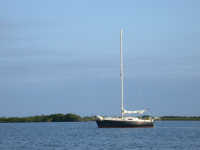 |
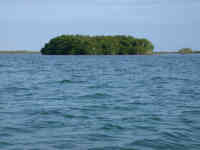 |
| Malakii | Douglas Cay |
I spent the next day poking around this new part of Turneffe I'd never visited before. There were ten or fifteen foot deep channels through the mangroves, but each time I thought I might have found a place to sail in, I discovered there was a bar across the mouth of it which made it too shallow.
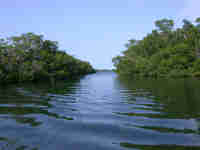 |
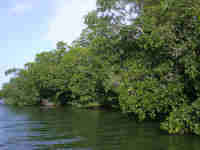 |
 |
| Near Douglas Cay | Mangroves |
I took the dink and motored west, looking for the submerged reef which surrounded the Turneffe Atoll. I wanted to see how deep it was, and whether I could indeed sneak over it. After fifteen minutes of motoring over a grassy bottom in ten to twenty feet of water I finally found it. It came clear up to the surface in spots, and was particularly shallow in general. There might be a way through it farther south, but it would take some searching to find a safe place. A job for another time. There is a white marker post and a red buoy on the reef, more or less on a line between Douglas Cay and English Cay. I anchored the dinghy and snorkled through the reef. On the outside, there was lots to see, but nothing to show here, as I don't have an underwater housing for my camera. The dink has a 9# grapel anchor on ten feet of 1/4" chain, and 50 feet of rode. Even so, with a 10 knot wind, it dragged a little. Rubber dinghies have a lot of windage... Not a particularly comforting thought when you're a mile or so from your main vessel.
After frying up a fish I'd speared for dinner, I spent the evening trying to figure out how large the ice box is. It's a fairly simple shape, and ought to be easily computable via first year calculus. Unfortunately, I couldn't remember enough of mine. Amber would have remembered, and enjoyed it.
The next morning I headed out early, intending to sail to Lighthouse Reef, another of Belize's offshore atolls. As I sailed out in a stiff breeze, I noticed the prop shaft was rattling. I put the engine in gear (without the engine running) to stop the shaft turning, but it continued to spin. Damn! The shaft was loose from the drive saver / transmission, again. I turned the helm over to Auto, emptied the cockpit locker, and stuck a pipe wrench on it to keep it from turning. I decided the sea gods were telling me I wasn't quite ready to leave Turneffe. I continued south for a mile or two to a cut I had noticed on the way up, a cut which wasn't marked on my chart. I anchored just outside it, then spent an hour reconnecting the shaft. In the process, I discovered I con't have spare bolts for it. Ouch! Something to get next time I'm ashore. I also discovered the value of a Woodruff key over a long square key. A woodruff key is half-moon shaped, and sits in a half moon shaped hold machined out of the shaft. The depression is more expensive to make, as is the key itself. But the shaft can't slip out the way it can with a square key in a square slot cut all the way into the shaft from the end.
I spent the rest of the day exploring by dink. Apparently one of the hurricanes in the past twenty years had opened up this cut. It provided great access to the inner lagoon, but as before, it was too shallow for Malakii.
Many of the mangrove cays had fishing shacks on them. Some had real dirt of some kind, and the fishermen had planted coconuts, or else discarded or washed up coconuts had taken root. On another, it looked like a new place was just going up. There was no solid ground; everything was being built on stilts among the mangroves.
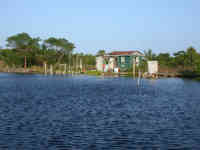 |
 |
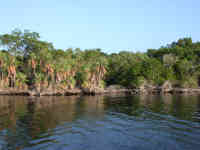 |
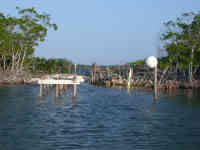 |
|
| Fishing Shack | New Palms | Starter Fishing Shack |
 |
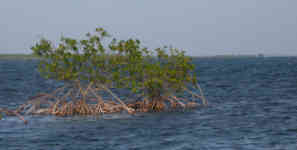 |
| Spreading Mangroves | New Cay Forming |
The wind piped up pretty good; the whole inner lagoon was covered with white caps. The inner lagoon was dotted with mangrove islands with shallow flats all around; a perfect habitat for manatees, bonefish, and salt-water crocodiles.
 |
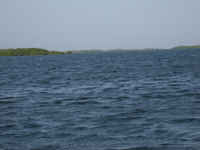 |
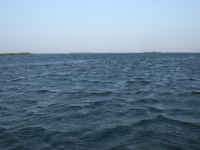 |
| Southern Lagoon |
That evening, some local fishermen came by asking if I wanted to buy fish, conch, or lobster, in spite of lobster being out of season. They had what looked to be a dolphin in their boat. For some reason they made me nervous.
The next morning I headed to Lighthouse Reef, home of the famous Blue Hole. I'd been to Lighthouse some years before, on a dive boat, but I'd never sailed there. I left early, sailed down to the tip of Turneffe, then turned east. The wind was light. Seems like the "off by one" problem carries over into sailing. In computing, when dealing with indexed arrays, there is always the issue of whether the index starts at zero or one. Hence the potential for being off by one -- you write code as if the index started at zero or one, but in fact it starts with the other. In sailing, it seems like the day I am anchored, there is a great wind; and the day I am sailing, there is little wind and I should be snorkling or exploring.
I had a lone dolphin accompany me for a while shortly after I started. A little unusual -- usually there is a small pod of them. The mate or offspring of the one the fishermen had killed yesterday?
The wind was, as usual, on my nose, but I had a delightful sail over. As I neared Long Cay, a steady stream of dive boats and sailboats motorsailing headed in through the cut north of Long Cay, heading towards the Blue Hole and Half Moon Cay. They all seemed somewhat frantic, as if they had blinders on and were in a luge run, all being funneled towards the scenic attraction of the hour. In addition, four large live-aboard dive boats were hanging on dive balls along the reef.
As you approach Lighthouse, the Caribbean Sea goes from 600 or more feet to about 40 feet in a matter of a few yards, and then to close to nothing in 50 yards or less. On the chart in my cruising guide, it looks like there is a wide (mile!) opening in the reef to enter the lagoon on the west side of Long Cay. Instead, I found coral everywhere and shallow depths. I sailed in close at a couple of spots but decided it wasn't deep enough and backed off, continuing to probe southward. Fortunately, I had good light behind me. Wind on the nose is good at this point, as it makes it relatively easy to slow down and back off. Eventually I spied a narrow cut. Wind on the nose is not so good at this point, as I had to zigzag through a number of coral patches as I went through the cut. In due course we were inside, and I sailed up to the northern end. I found a large sand patch and dropped the anchor in my own little swimming pool, complete with coral patches on the edges to explore.
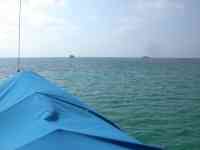 |
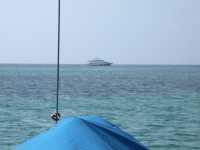 |
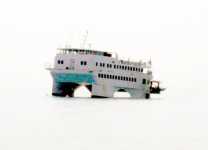 |
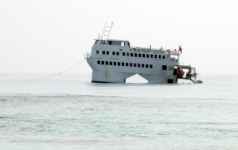 |
| Dive Boats off Long Cay | Sun Dancer III | Nekton Pilot |
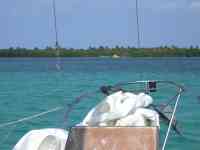 |
 |
| Long Cay Lagoon | Malakii at Long Cay |
The water around Lighthouse is crystal clear, just as it was at Glovers. The sudden drop-off along the reef makes for spectacular diving, and the reef comes close enough to the surface for great snorkling as well. I took an evening snorkel; a large Green Moray Eel came out to greet me. It was a bit eager, and made me a little nervous. I wondered if the dive boats fed it, but it was probably just my own insecurity. I also verified there was a narrow cut going through the reef from here, just deep enough for us, and maybe 30 feet wide. I wouldn't have to retrace my steps to get out.
Boy, all I have to do is think about doing a solo dive or a difficult passage, and I get a mild case of diahrhea. I guess that's not new; the same thing used to happen before a climb or a difficult rapid.
The diving was spectacular. There are gorgeous spur and groove coral formations all along the drop-off, ten to twenty foot deep canyons with sandy bottoms. I cruised up and down, in and out, and saw large nurse sharks, large barracuda, large large tarpon, snapper, and saucereye porgy. The view over the edge is awe-inspiring, and it's a treat to float along out in the blue, nothing below as far as you can see, just inches from a tapestry of brilliant color and amazing geometry.
Ouch! I set a dive tank down rather emphatically on my big toe, right foot, when switching tanks. So now it's turning black and blue, and will maybe fall off to match what's happening on my left toe from hiking in the too small rubber boots a month ago.
I sailed out the narrow cut west of Long Cay, then back in through cut north of Long Cay; then over to Half Moon Cay on the east side. It was very hazy, and I could barely make out the old shipwreck on the east reef, needed for a bearing. I imagined doing this in the US northwest or northeast on a fogbound coast with serious tides to worry about, plus a lot of boat traffic. I'm still a little weenie in this game.
I took the dink in to Half Moon Cay. It's a picture perfect place, picnic tables under palm trees, white sandy beaches, conch shells all over, nice sandy walkways through the woods. Swept daily, apparently.
Belize's first protected area, Half Moon Cay Natural Monument was originally established in 1928 to protect the Booby colony which nests here. It is maintained by the Belize Audubon Society in conjunction with a European Union organization. There were baby Frigate Birds wandering around on the beach, looking like... dumb baby birds.
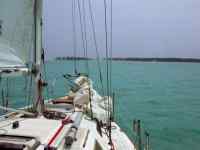 |
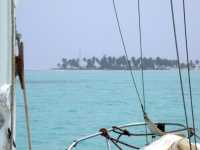 |
 |
| Approaching Half Moon Cay | Half Moon Cay |
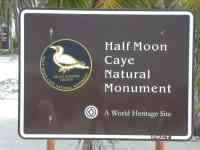 |
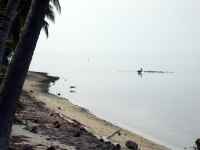 |
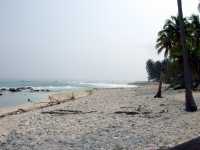 |
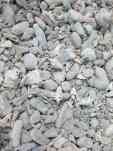 |
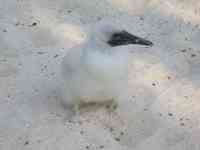 |
| Pelican, North Side | South Side | South Side Close-up, Conch Shell and Coral |
All baby birds look dumb! |
The bird sanctuary on Half Moon Cay is a cool place. It's a tiny littoral forest, a type of coastal habitat made up of vegetation found on higher land along the mainland coast and on forested cayes. The forest on Half Moon Caye is a climax littoral forest, where the Orange Flowered Ziricote is the primary species. Other plants in the Half Moon Caye forest are the Gumbo Limbo tree, Silver-Grey bushes, White-Flowered Spider Lily, and the Sea Grape.
The Gumbo Limbo is also known as the "Tourist Tree" because its red, shaggy bark is always peeling, like a sun-burned tourist. It grows up to 25 meters in height. The bark of the Gumbo Limbo is used as a remedy for skin sores, measles, sunburn, insect bites, and rashes. It is also taken internally for urinary tract infections, colds, fevers, flu, and to purify the blood. A real cure-all!
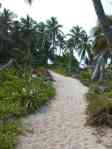 |
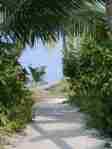 |
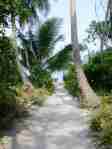 |
|
| Manicured Path | |||
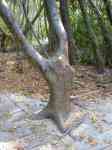 |
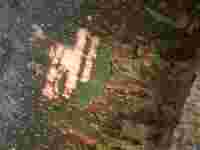 |
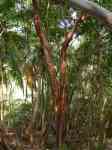 |
|
| Gumbo Limbo | |||
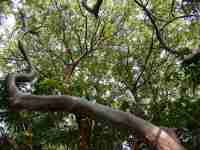 |
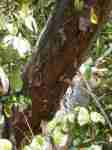 |
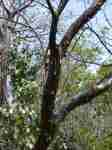 |
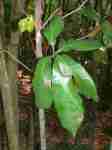 |
| More Gumbo Limbos |
The Gumbo Limbo trees are full of Frigate Birds and Booby Birds. Frigate birds have up to a seven foot wingspan. They fly well, but don't dive well and cannot land (and take off!) on water. So they harass other birds, like the Boobies, and try to rob them of whatever food they have. This happens in mid-air, and is interesting to watch. Apparently they also will rob the nests of both eggs and young.
Booby birds live on the island for ten months, nesting in November and laying eggs, one per nest, in December. Both parents incubate the egg, which takes seven weeks to hatch.
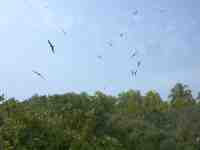 |
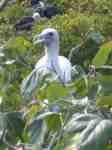 |
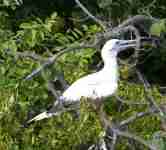 |
| Frigate Birds |
Underneath the Gumbo Limbo trees there were Hermit Crabs and Iguanas. Iguanas aren't exactly rare, but in many parts of Belize and Central America they are killed for food. Apparently they taste pretty good. But as with many things, too many people make it difficult for the rest of the world's creatures to survive, so unless you are in a protected area you seldom see any large iguanas. The only other place I've seen any was along the Belize river in the Community Baboon Sanctuary.
The large iguanas on Half Moon Cay are Green Iguanas, locally known as a "Bamboo Chicken." They can grow up to seven feet long. Because they taste so good and have been hunted so intensively, they are now endangered, and Half Moon Cay serves as a refuge for them. There is also a smaller iguana, the Spiny-Tailed, also known as a WishWilly.
 |
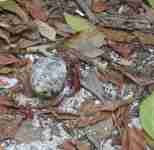 |
| Hermit Crab |
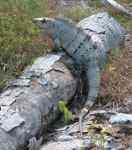 |
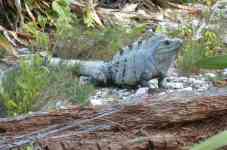 |
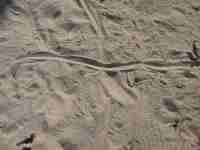 |
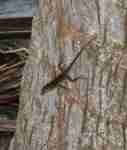 |
| Iguana | Iguana | Iguana Tracks | Small Lizard |
There is a small platform in the middle of it all, where you can climb up and be at tree top level, looking birds in the beak a few yards away.
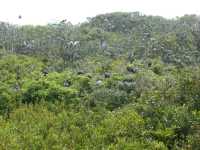 |
 |
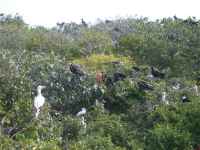 |
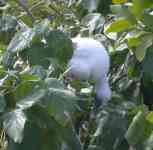 |
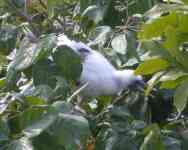 |
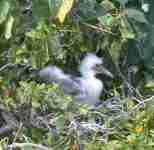 |
| Baby Frigate Bird |
There is a new light tower on the east end of the island. The old one got trashed in a hurricane, I think. The light tower is 90 feet tall, by far the tallest thing around. I climbed it to see what the view was like. It's much like climbing the one at English Cay -- rusty painted iron rungs about a foot apart, straight up. I have to do it kinda sideways, and I still bark my knees. Wonderful perspective from the top.
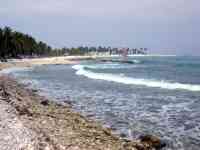 |
| East End with Lighthouses |
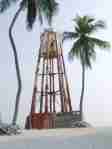 |
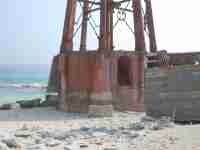 |
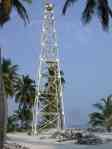 |
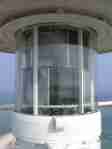 |
| Old Lighthouse | Base of Old Lighthouse | New Lighthouse | New Lighthouse Top |
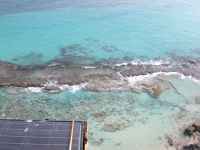 |
 |
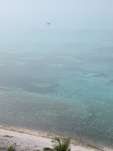 |
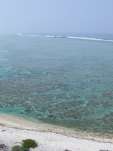 |
| Looking down... South | East | North to Malakii | North to Wreck |
My dive tanks were empty, and there were five biggish dive boats anchored off the beach. So I went over and asked it I could pay them to fill my tanks for me. As they weren't live-aboard boats, they didn't have a big compressor. In fact, their compressor was the small one I would like to have on Malakii. But they were nice enough to say they would fill me up, but said I should bring my tanks over about 7 pm.
 |
| Dive Boats |
I went back to Malakii, and then over to the wreck on the eastern reef. Even on this nice day, when it was dead calm inside the reef, the surf was pounding on the outer reef. I would not want to be upwind of it on a bad day.
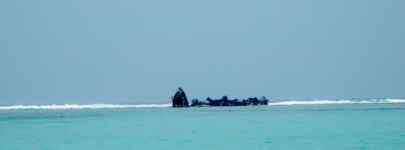 |
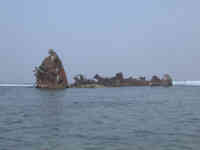 |
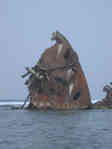 |
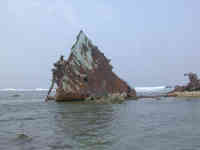 |
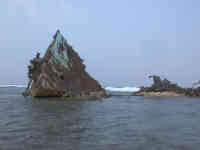 |
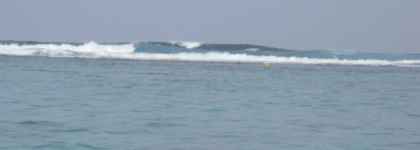 |
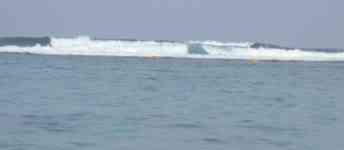 |
| Waves |
I found a fun place to snorkel near the wreck, and spent an hour or so wandering around. I found a lobster in hiding, and lots of the usual daytime fish. On my way out, I passed right over a large stingray. It swam off, but not too far. It didn't seem too shy, so on the way back I went slow and managed to sneak up near it for some photos.
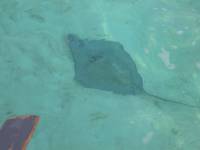 |
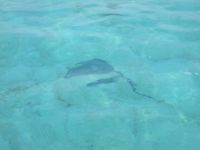 |
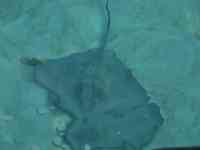 |
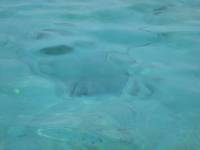 |
| Stingray |
I returned to my snorkeling place towards dusk. With the sun going down, the activity level picked up. The lobster came out to start hunting, and the daytime fish were acting skitterish as the nighttime predators began to get more aggressive. Unfortunately, I missed the best time, when the sun was going down, as I had to deliver my dive tanks for filling.
I dropped off the tanks, then went back to snorkel some more in the dark. It wasn't nearly as frantic as it had been at dusk, but it was still fun.
Half Moon Cay is one of several islands where turtles come to lay their eggs. I was a little surprised, as the beach doesn't seem to have much in the way of sand for them to lay their eggs in, but apparently it is enough.
Two species of sea turtles nest here: the Green and the Loggerhead. Hawksbills have also been sighted. All are endangered. The turtles migrate hundreds (in some cases, thousands) of miles from feeding areas to nesting beaches. Much like salmon, they home to the same beach where they were born. They lay eggs in April and May, and the young hatch in July and August, heading immediately to the sea. The young can get disoriented by bright lights, so an important aspect of protecting turtles is maintaining a dark environment during emergence of the little squirts.
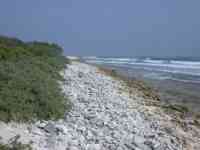 |
| Turtle Nesting Beach |
Half Moon Cay is much as it was five or six years ago, except a Canadian outfit now has some primitive tent camps between the dock and the bird / nature walk. It looks like a great low impact way to visit, much preferable to the expensive resorts one sees built up everywhere else.
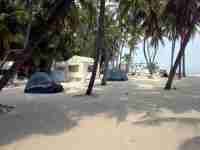 |
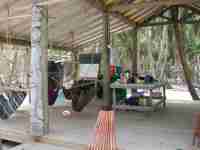 |
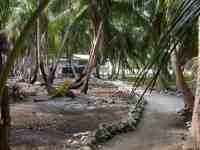 |
| Outfitter Camp |
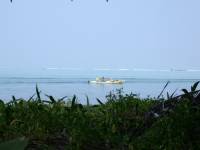 |
 |
| Returning Kayakers... | Shipwreck and Fringing Reef
in Background |
I wanted to see the Blue Hole again, so one morning I weighed anchor and sailed north. All the way up, I met dive boats returning. I figured with that many boats around there was sure to be plenty of them still there when I arrived. I had a GPS waypoint I had figured out from the chart for one of the entrances. I had what I thought was a good image of it in my mind from all the pictures I have seen, but when I got to my waypoint, I was confused. It didn't look like the Blue Hole. It didn't seem dark enough, deep enough, or big enough, and there weren't any large dive buoys like there were off Long Cay. As popular a dive site as it was, I expected a number of large buoys to make managing the many dive boats easier and thereby help protect the reef. I spent a few hours sailing around, refiguring my position, backsighting on the one wreck that was visible as a reference. I sailed into it, watching the depth sounder, but it only went to 140 feet or so, not the 400+ feet which would indicate I was really there.
As the route up requires good light to avoid all the coral patches, I headed back south for the night, discouraged. I felt I had missed it. To figure out what went wrong, I had taken a lot of GPS waypoints as I sailed around. When I got home, I compared them to aerial photos, and verified that I actually had been in the right place, but didn't recognize it. I'm still puzzled by the shallow depth, but I must have just not been in the center enough.
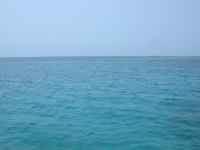 |
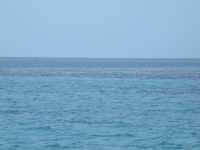 |
| Blue Hole |
There was a norther predicted to come in, and my time in Central America was about up, so I left Half Moon Cay and went back out and picked up a dive ball outside Long Cay. I did a final, late afternoon dive; it was great, with lots of big fish around. Early the next morning I set out through the mist for the barrier reef, which I crossed at Southwater Cay; and then on in to Placencia, where I would check out.
Prev (Gringo Bay)
Next (Return to Rio Dulce)